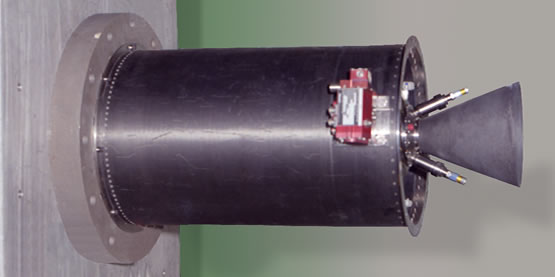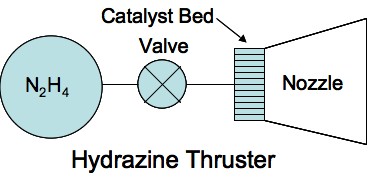propulsion systems
Four different aerospace propulsion systems are involved throughout this mission. First, the Minotaur V launch vehicle is used to launch Googol and inject it into a lunar transfer orbit. Second, Googol is outfitted with a Pulsed Solid Assist Motor (PSAM) that is used to insert the vehicle into lunar orbit, adjust its orbit, and perform a deorbit burn. Next, a monopropellant hydrazine descent engine is used for powered descent onto the lunar surface. Lastly, the lander incorporates a Reaction Control System (RCS) composed of cold gas thrusters which control the attitude of the vehicle during flight. Each one of these systems, with the exception of the RCS, will now be discussed in greater detail. Due to its dependence on the physical design of the spacecraft, the RCS was not developed in any significant detail in this proposal.
Minotaur V
The Minotaur V, manufactured by Orbital Sciences Corporation, serves as the launch vehicle for this mission. According to Orbital Sciences, the Minotaur V provides “an extremely cost-effective capability to launch small spacecraft into high energy trajectories, including Geosynchronous Transfer Orbits (GTO), as well as translunar and beyond.” The Minotaur V is a five-stage launch vehicle based on the Peacekeeper ICBM and derived from the Minotaur IV. The first three stages of the Minotaur V are the unmodified Peacekeeper solid rocket motors. Stages 4 and 5 are Star 48V and Star 37FM/Orion 38 solid rocket motors. The Minotaur V’s payload capability of 465 kg to lunar injection is more than enough to accommodate Googol’s 241 kg. The image below displays the Minotaur V alongside other launch vehicles in the Minotaur family.

Pulsed Solid Assist Motor (PSAM)
The PSAM is a small yet powerful solid rocket motor attached to the Googol lander for the purpose of providing delta-V for lunar orbit insertion, inclination change, and deorbit. Following these three maneuvers, the PSAM is jettisoned. The PSAM is a purely conceptual design based on ATK’s Star 15G solid rocket motor. The main difference between the Star 15G and the PSAM is the fact that the PSAM is “pulsed.” A standard solid motor cannot be stopped and restarted once it has been ignited. However, a pulsed solid motor uses dividers to separate the propellant into many smaller segments that burn independently. Using a pulsed motor instead of a standard solid rocket motor allows for slight adjustments in the delta-V of pre-planned maneuvers to be made. This gives mission planners much more flexibility should the spacecraft drift off course. Based on the specifications of the Star 15G, below are the performance specifications of the PSAM:
Motor Diameter |
15.04 in |
Motor Length |
31.57 in |
Isp |
285 s |
Maximum Thrust |
2,800 lbf |
Nozzle Throat Diameter |
0.97 in |
Nozzle Exit Diameter |
8.12 in |
Dry Mass |
13.4 kg |
Propellant Mass |
110 kg |
Propellant |
TP-H-3340 |

PSAM Delta-V Calculations
Delta-V capacity for the PSAM was simply calculated using the Rocket Equation below:
![]()
Using the Rocket Equation, it was verified that the PSAM would deliver the necessary delta-V for the planned lunar orbital maneuvers. Below is the breakdown of those maneuvers:
PSAM Delta-V Budget
PSAM Available Delta-V |
1708.747 m/s |
Lunar Orbit Insertion |
859.152 m/s |
Adjust Inclination |
164.2 m/s |
Delta-V Available for Deorbit |
685.394 m/s |
Remaining Delta-V after maneuvers |
0 m/s |
Monopropellant Hydrazine Descent Engine
A single monopropellant hydrazine thruster is used to power the lander’s descent onto the lunar surface. A hydrazine thruster differs significantly from a common liquid chemical thruster in three major respects. First, most chemical rocket engines use bipropellants—that is, fuel and oxidizer are carried separately in two different tanks. A hydrazine thruster simply carries liquid hydrazine in a single tank. Second, most chemical rocket engines operate on combustion. A hydrazine thruster operates on a catalyst-induced decomposition reaction and thus no combustion takes place. Lastly, hydrazine thrusters are much simpler than liquid bipropellant rockets and are therefore much cheaper.

The chemical reactions for hydrazine decomposition are displayed below:

As one can see, hydrazine first decomposes into ammonia and nitrogen in an exothermic reaction. Subsequently, depending on a number of factors, ammonia will further decompose into both nitrogen and hydrogen in an endothermic reaction. In order to maximize energy release, it is desired to operate at a fairly low rate of ammonia decomposition. This descent engine will be operating at 30% ammonia decomposition.
Using historical hydrazine thruster data and standard propulsion calculations and analysis, specifications were selected for the hydrazine descent engine. These calculations were performed using Engine.m, which is a subset of Trajsim.m—the terminal descent simulation. The output of Engine.m is displayed below:
Monopropellant Hydrazine Thruster Analysis
------------------------------------------
Tank pressure 20 atm
Area ratio 50
Max Thrust 400 N
Isp 255 sec
Char Velocity (C*) 1350 m/s
Thrust Coeff (Ct) 1.87112
Throat Diameter 0.0115894 m^2
Exit Diameter 0.0819495 m^2
Bell Nozzle Length 0.0919056 m
Var T mdot (AVG) 0.147814 kg/s